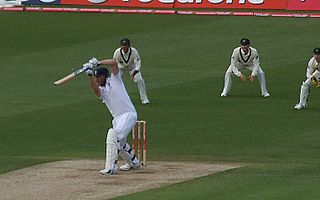
Bodyline, also known as fast leg theory bowling, was a cricketing tactic devised by the English cricket team for their 1932–33 Ashes tour of Australia. It was designed to combat the extraordinary batting skill of Australia's leading batsman, Don Bradman. A bodyline delivery was one in which the cricket ball was bowled at pace, aimed at the body of the batsman in the expectation that when he defended himself with his bat, a resulting deflection could be caught by one of several fielders deliberately placed nearby on the leg side.

The wicket-keeper in the sport of cricket is the player on the fielding side who stands behind the wicket or stumps being watchful of the batsman and ready to take a catch, stump the batsman out and run out a batsman when occasion arises. The wicket-keeper is the only member of the fielding side permitted to wear gloves and external leg guards. The role of the keeper is governed by Law 27 and of the Laws of Cricket.

This is a general glossary of the terminology used in the sport of cricket. Where words in a sentence are also defined elsewhere in this article, they appear in italics. Certain aspects of cricket terminology are explained in more detail in cricket statistics and the naming of fielding positions is explained at fielding (cricket).

An all-rounder is a cricketer who regularly performs well at both batting and bowling. Although all bowlers must bat and quite a handful of batsmen do bowl occasionally, most players are skilled in only one of the two disciplines and are considered specialists. Some wicket-keepers have the skills of a specialist batter and have been referred to as all-rounders, but the term wicket-keeper-batter is more commonly applied to them, even if they are substitute wicket keepers who also bowl.

In cricket, batting is the act or skill of hitting the ball with a bat to score runs and prevent the loss of one's wicket. Any player who is currently batting is, since September 2021, officially referred to as a batter —regardless of whether batting is their particular area of expertise. Batters have to adapt to various conditions when playing on different cricket pitches, especially in different countries; therefore, as well as having outstanding physical batting skills, top-level batters will have quick reflexes, excellent decision-making skills, and be good strategists. Although batsman is still widely used.

In cricket, a dismissal occurs when a batter's innings is brought to an end by the opposing team. Other terms used are the batter being out, the batting side losing a wicket, and the fielding side taking a wicket. The ball becomes dead, and the dismissed batter must leave the field of play for the rest of their team's innings, to be replaced by a team-mate. A team's innings ends if ten of the eleven team members are dismissed. Players bat in pairs so, when only one batter remains who can be not out, it is not possible for the team to bat any longer. This is known as dismissing or bowling out the batting team, who are said to be all out.

The captain of a cricket team, often referred to as the skipper, is the appointed leader, having several additional roles and responsibilities over and above those of the other players. As in other sports, the captain is usually experienced and has good communication skills, and is likely to be one of the most regular members of the team, as the captain is responsible for the team selection. Before the game the captains toss for innings. During the match the captain decides the team's batting order, who will bowl each over, and where each fielder will be positioned. While the captain has the final say, decisions are often collaborative. A captain's knowledge of the complexities of cricket strategy and tactics, and shrewdness in the field, may contribute significantly to the team's success.

A partnership is a term used in cricket, that usually refers to the two batters and the runs they score together, including extras. Two batters bat in a partnership, although only one is a striker at any time. The partnership between two batsmen will come to an end when one of them is dismissed or retires, or the innings comes to a close, usually due to victory being achieved, a declaration, a time or over limit being reached, the match being abandoned. In exceptional cases, if one of the original batters are injured, a player may run between the wickets on behalf of the injured batter. However, any runs scored by the injured batter will be recorded as being in the partnership of the two original batters. A partnership may also refer to two bowlers bowling from each end of the wicket.

The 2005 Ashes series was that year's edition of the long-standing cricket rivalry between England and Australia. Starting on 21 July 2005, England and Australia played five Tests, with the Ashes held by Australia as the most recent victors. The final result was a 2–1 series win for England, who succeeded in their biennial attempt to win the urn.
In cricket, the batting order is the sequence in which batters play through their team's innings, there always being two batters taking part at any one time. All eleven players in a team are required to bat if the innings is completed.

Alan Falconer Kippax was a cricketer for New South Wales (NSW) and Australia. Regarded as one of the great stylists of Australian cricket during the era between the two World Wars, Kippax overcame a late start to Test cricket to become a regular in the Australian team between the 1928–29 and 1932–33 seasons. A middle-order batsman, he toured England twice, and at domestic level was a prolific scorer and a highly considered leader of NSW for eight years. To an extent, his Test figures did not correspond with his great success for NSW and he is best remembered for a performance in domestic cricket—a world record last wicket partnership, set during a Sheffield Shield match in 1928–29. His career was curtailed by the controversial Bodyline tactics employed by England on their 1932–33 tour of Australia; Kippax wrote a book denouncing the tactics after the series concluded.
The Bangladeshi cricket team toured Sri Lanka for three One Day International cricket matches and two Test cricket matches in August and September 2005. The Bangladeshi team was coming off a moderately successful tour of England, as they had pushed Australia close in one ODI and beat them in another. However, they had still lost five out of six matches in the NatWest Series, both of the Test matches, and remained at the bottom of both the ICC Test Championship and ICC ODI Championship. The hosts Sri Lanka, meanwhile, were undefeated in home ODI tournaments since February 2004, and in home Test series since March 2004, both against top-ranked Australia. Their win in the Indian Oil Cup a month before this series saw them into second place in the ODI Championship, but they are only ranked sixth in Tests.
The South African cricket team toured Australia for cricket matches during the 2005–06 season. South Africa had already played two One Day International series during this season, beating New Zealand 4–0 at home before travelling to India and drawing the series there 2–2. The team had been playing 14 successive ODIs before arriving in Australia, with their last Test match against West Indies in April and May 2005. South Africa played one first class warm-up match, one three-day warm-up match without first class status, and one one-day match before they embarked on the three-Test series, which began on 16 December and ended on 6 January. They also participated in the 2005–06 VB Series, a three-team one-day tournament, along with Australia and Sri Lanka, where they finished last.
The England cricket team toured Sri Lanka in February 1982. The tour included two One Day International (ODI) matches and one Test match. Sri Lanka had become a Test playing nation the year before, and this was their inaugural Test match. Many celebrations had been prepared in Sri Lanka, include the issuing of commemorative stamps and coins.
Sulieman Jamaal Benn is a West Indian former cricketer who played international cricket for the West Indies and first-class cricket for Barbados. Benn was a member of the West Indies team that won the 2016 T20 World Cup.
This article contains information, results and statistics regarding the Australian national cricket team in the 2008 season. Statisticians class the 2008 season as matches played on tours that started between May 2008 and August 2008.

Sam Loxton was a member of Donald Bradman's famous Australian cricket team, which toured England in 1948. Bradman's men went undefeated in their 34 matches; this unprecedented feat by a Test side touring England earned them the sobriquet The Invincibles.
The New Zealand cricket team toured Australia from 18 November – 13 December 2011. The tour consisted of two Tests played for the Trans-Tasman Trophy.
The England cricket team toured Sri Lanka in October and November 2018 to play three Tests, five One Day Internationals (ODIs) and one Twenty20 International (T20I) match. The tour included England's first Test matches in Sri Lanka since 2012.
The Ireland cricket team toured England in July 2019 to play a one-off four-day Test match at Lord's. It was the first Test match to be played between the two sides, and was England's first four-day Test match since they toured New Zealand in 1971. It was Ireland's third Test match, and their twelfth international fixture against England.











